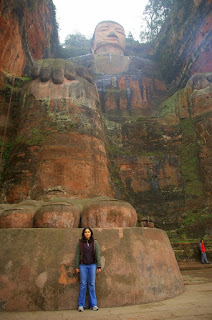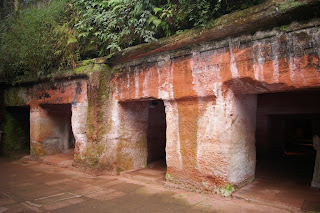"With fingernails bigger than the average human, the worlds tallest Buddha draws tourists to this relaxed riverside town"We were going alone by bus so we got co-workers to write down a variety of useful phrases for us to wave at ticket vendors, taxis, and so on:
Chengdu Transportation Center: 新南门旅游客运中心We printed all this in nice big text and felt ready to roll.
Le Shan (Big Buddha): 乐山(大佛)
I want to buy two bus tickets to LeShan (Big Buddha)
买两张到乐山(大佛)条件最好的空调车票
I want to buy two bus tickets to Chengdu
买两张到成都(新南门客运中心)条件最好的空调车票
Could you please take us to this bus? (show the guy your ticket)
请带我们到这辆车.
Please take us to the LeShan Big Buddha.
请带我们到乐山大佛景区
Take us to place to buy tickets for boats viewing Big Buddha?
请带我们到乐山大佛游船的售票点?
Take us to tour boat?(show the guy your ticket) 请带我们到游船?
Price (by type) one-way: 34.50/36.50
Bus Times: 8:10—19:35
One bus every 30 minutes. Two hours Chengdu to Le Shan
The morning of the trip we headed out to the transportation center, waved the "I want to buy tickets to Le Shan" (which also says we want the best tickets possible) at the lady and purchased tickets. We expected to pay ¥36 each for a bus ride to the Le Shan bus station, which is annoyingly far from the attractions, and then take a taxi to the Buddha. The price was instead ¥51 and our bus wasn't exactly a bus:
The van was actually much more comfortable than a bus so we figured it was OK. Shortly after we set out the driver pulled over, got out of the vehicle, and started smoking. We inquired with the other passengers about what was happening and gradually gathered he was waiting for someone else with a package he'd be delivering to Le Shan. Odd. Shortly thereafter a small package showed up by scooter and we took off.
The van was much faster than a bus (based on passing numerous buses) so we felt we were generally better off than expected. Until the van driver started smoking. Rod tapped him on the shoulder and urgently mimed window opening, which gradually got through.
An hour or so later the van pulled over on the side of the highway. This turned out to be the package dropoff point; after a minute or two another van showed up, the package was passed, and we were off again. We entered Le Shan and learned that one advantage of the van was that it takes you right to the giant buddha area instead of dropping you at the distant bus station and forcing you to take a taxi.
From the drop point it is necessary to walk a short distance to the ticket office. We walked with a couple from Baotao in Inner Mongolia who spoke some English.We wound up wandering around Le Shan with them all day and ultimately taking the same bus back.
Along the way to the ticket office we saw trees that were confused about the need to place roots into the ground. Apparently this tree is quite well known. Unfortunately we forgot the name.
We also saw a motorcycle whose occupant was ... not with it ... in a curious position.
After purchasing tickets for the buddha (which also includes entrance to Wuyou Temple (or Wūyóu Sì)) and the Mahaoya Tombs) we start up the stairs. The buddha is 71m tall so it takes a decent number of stairs to wind their way to head-height.
The size of the buddha becomes apparent when you look down at the ant-like people crowded around his feet.
To get down to the feet you descend a narrow staircase on the side of the cliff. This is populated by jackasses from tour groups who keep shoving you until you inform them the next shove will earn them a free flight to the bottom (probably not understood but the guy definitely followed that we were pissed). People who join tour groups are 74% more likely to be jackasses than a random person off the street. Along the side of the stairs are very nice little alcoves with sculptures.
From the bottom you can begin to appreciate just how big the buddha is.
When you proceed up the other side of the grand buddha you come out into a very nice, very green, set of grounds.
There are a number of other minor attractions in this area. They have stone stellae, a statue of a stern looking chap who was probably somehow associated with building the area and apparently lived for some time in a nearby cave, and various other items.
There was a small area dedicated to a fellow who (if we understood correctly) wrote history along with his two sons. There were some very nice line art pictures of him. The best one was also the first picture we've seen of clogs in China.
We also saw a cool tree and enjoyed some remarkably steep stairs up to a very peaceful little buddhist prayer area (and, naturally, shop).
This area had some neat statues in little niches, and some very nice roof adornment. Perhaps when we build our duplex we can do something in this style :)
The view out over the grounds, with traditional buildings peeking out through the foliage, was quite nice too.
Next we walked out the south exit, through the "fishing village", and spotted the entrance (thought we didn't know it at the time) to Woyou Temple.
Just to the left of where you enter Woyou Temple are the Mahaoya Tombs. These are small artificial caves with some vases, small statues and the like in them.
From the bridge to Woyou Temple you can get a nice view back on the fishing village.
Woyou Temple is YABT (Yet Another Buddhist Temple). To get to it one must ascend a good number of stairs.
At the top a lady tried to sell us a rough wooden cup for ¥50. We laughed and said we'd seen similar items for less in Chengdu and the price was revised to ¥10. This was so cheap we couldn't resist.
Woyou Temple has a novel hobbit door, a nifty painting, a dragonfish, and a grass dragon to distinguish itself from other Chinese buddhist temples.
At this point it was late afternoon, getting darker, and everyone seemed ready to leave. Luckily the couple from Baotao had the phone number for the van service so we got picked up at the base of Woyou Temple, ferried to a gas station, and shortly thereafter picked up by a big bus. This cost ¥45 each but again saved us a taxi to the real bus station so it probably wasn't much more expensive.
The bus ride back was much slower than the van there, and bumpier, and noisier. As a result we may not have been in the best mood when we got out. On exiting the bus in the Chengdu station we were mobbed by taxi drivers and other people who wanted money for god knows what. The taxi drivers in the station naturally wanted to negotiate fixed rates rather than run the meter. At one point it was necessary to walk single file through a hall wide enough for three because both sides were lined with these pests. The refusal to run the meter coupled with continued attempts to grab arms to delay you while the sales pitch was made evidently irritated Rod who explained to several of them in rather irate terms that they were a bunch of cheats.
We walked out, flagged a legitimate taxi, and went to Peters Tex Mex for dinner. As expected the meter rate was 40% less than the fixed rate bargains available at the bus station. Sadly this is our last weekend in Chengdu; next week on Friday we start a six week vacation by flying to Kunming.



























No comments:
Post a Comment